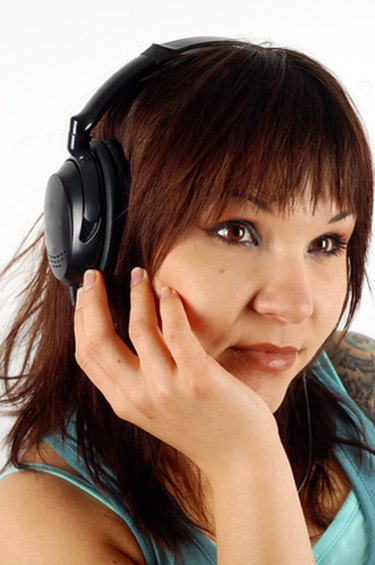
Mapping the mental activity of the brain shows that music stimulates parts of this organ just as food, drugs and sex do, reveals a report in the "Canadian Geographic" magazine. It is apparent that music can affect emotions and mood in the vast majority of individuals. Several areas of the brain are activated when listening to music, and even more areas are stimulated and participate in playing music.
Auditory Cortex
Video of the Day
The auditory cortex is mainly part of the temporal lobe at each side of the brain, slightly above the ears. The brain cells in this area are organized by sound frequencies, with some responding to high frequencies and others to low ones. The auditory cortex analyzes the information from the music such as the volume, pitch, speed, melody and rhythm, according to the "Canadian Geographic" magazine and Alzheimer's Disease Research.
Video of the Day
Cerebrum
The frontal gyrus is located in the cerebrum, which is the largest part of the brain and located at the top and front of the head. The inferior frontal gyrus is associated with recalling memories to remember music lyrics and sounds when they are heard or sung. Another area in the cerebrum called the dorsolateral frontal cortex is stimulated when hearing music to keep the song in working memory and bring up images that are associated with the sounds, and to visualize the music when playing it, according to the National Institute of Neurological Disorders and Stroke. The motor cortex is also an area of the cerebrum. It helps to control body movements such as when playing a musical instrument, by processing visual and sound cues.
Cerebellum
The cerebellum is located at the back of the head, below the cerebrum. The National Institute of Neurological Disorders and Stroke explains that this organ is the second largest in the brain and is a vital control center for reflex actions, balance, rhythm and coordinating skeletal muscle movement. The cerebellum helps to create smooth, flowing and integrated movements when hearing or playing music. It works in harmony with other parts of the brain to affect rhythmic movement in the body when moving in response to the music. The cerebellum allows a performer to move the body in accordance to reading or visualizing music when playing a musical instrument, as described by the Center for Neuroskills.
Limbic System
The limbic system is composed of several interlinking parts that lay deep inside the brain. Alzheimer’s Disease Research notes that this part of the brain reacts emotionally to music, giving the listener chills, joy, sadness, excitement, pleasure and other feelings. The Newark University Hospital notes that the ventral tegmental area of the limbic system is the structure that is primarily stimulated by music, just as it is by eating, sex and drugs. The amygdala of the limbic system is the area typically linked to negative emotions such as fear and is normally inhibited when listening to music.
- "Canadian Geographic" Magazine: This Is Your Brain on Music
- The Newark University Hospital: Anatomy of the Brain
- Alzheimer’s Disease Research: Anatomy of the Brain
- Center for Neuroskills: Brain Functions and Map
- National Institute of Neurological Disorders and Stroke: Brain Basics: Know Your Brain
Is this an emergency? If you are experiencing serious medical symptoms, please see the National Library of Medicine’s list of signs you need emergency medical attention or call 911.